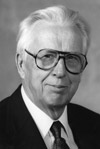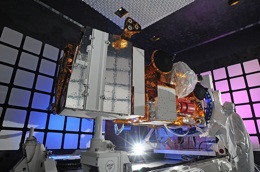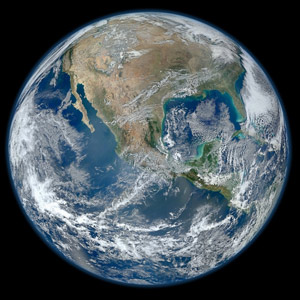Satellite renamed to honor UW-Madison space pioneer
NASA and the National Oceanic and Atmospheric Administration have renamed their newest Earth-observing satellite after Verner Suomi, a longtime UW–Madison professor who often is called the father of satellite meteorology.
A ’Blue Marble’ image of the Earth taken from the VIIRS instrument aboard Suomi NPP. This composite image uses a number of swaths of the Earth’s surface taken on Jan. 4, 2012. The NPP satellite was renamed ’Suomi NPP’ on Jan. 24, 2012 to honor the late Verner E. Suomi of the University of Wisconsin. View larger version »
Photo: courtesy NASA Goddard Space Flight Center
Launched into orbit on Oct. 28, 2011, the satellite known as the National Polar-orbiting Operational Environmental Satellite System Preparatory Project (or NPP) is now named Suomi NPP — the Suomi National Polar-orbiting Partnership.
“Verner Suomi’s many scientific and engineering contributions were fundamental to our current ability to learn about Earth’s weather and climate from space,” says John Grunsfeld, associate administrator of NASA’s Science Mission Directorate. “Suomi NPP not only will extend more than four decades of NASA satellite observations of our planet, it also will usher in a new era of climate-change discovery and weather forecasting.”
Suomi, who died in 1995 at the age of 79, spent nearly his entire career at UW–Madison after joining the faculty in 1948. He may be best known for the spin-scan camera, which allowed satellites in stationary orbit of one point on Earth to maintain continuous focus and enable, among other capabilities, the instant-replay-style weather images we watch on television. For more on Suomi, his passion for problem solving and his research drive, click here.

Suomi
In 1977, he received the National Medal of Science — one of many awards — though his son Eric Suomi expects his father would have been particularly appreciative of Suomi NPP’s mission and new name.
“I think this is an excellent match,” says Eric Suomi, an electrical engineer who lives in Madison. “Had my father still been around, he would have been pushing for more of the kind of instruments on this satellite and the observations they’ll be making of our planet.”
Suomi NPP, a joint mission run by NASA and NOAA, is a 4,700-pound, van-sized test bed for instruments planned to adorn the next generation of weather and climate satellites orbiting in north-to-south, south-to-north loops from pole to pole about 500 miles above the Earth. It’s a path similar to the one first flown in 1959 by Explorer 7, the 100-pound, laundry-basket-sized satellite that carried a radiometer built by Verner Suomi and UW–Madison colleague Robert Parent to measure the amount of heat coming and going from the planet.

The NPP satellite undergoes pre-launch testing at Ball Aerospace. (Photo: NASA/Ball Aerospace)
“Vern flew the first experiment to look at the Earth from space on Explorer 7,” says Hank Revercomb, a Suomi collaborator and director of UW–Madison’s Space Science and Engineering Center, which Suomi helped establish in 1965. “That was a radiation budget experiment, and there is actually a similar experiment, an instrument called ‘CERES,’ on the spacecraft they’ve named for him.”
Suomi NPP will also add to long-term climate records, monitor the health of the ozone layer, measure global ice cover and air pollution levels, map vegetation and — with the help of a sounder, an instrument conceived by Suomi and refined by Revercomb — contribute to better weather forecasts with sharper data on cloud cover, wind, temperature and atmospheric moisture.
Satellite meteorology has come a long way since Explorer 7, as any scientific field moves beyond what its leaders did during their lifetimes, according to Steve Ackerman, a UW–Madison atmospheric scientist and director of NOAA’s Madison-based Cooperative Institute for Meteorological Satellite Studies. But the NPP mission is vintage Suomi.
“This satellite is designed to study the atmosphere and improve our understanding of how and why changes make a difference in our weather and climate,” Ackerman says. “Those were Day One objectives of Verner’s from the 1950s.”
Researchers at the Madison satellite institute contributed to Suomi NPP’s programming, and will help translate its data into information useful to meteorologists, farmers, pilots, ship captains and almost anyone with an interest in the weather.
Suomi NPP, still new to orbit and in a mission-checkout phase, recently began sending data back to Earth. The satellite’s “first light” images were on display at the American Meteorological Society‘s conference under way in New Orleans, where NASA announced the name change.
Tags: engineering, federal relations, research, weather





